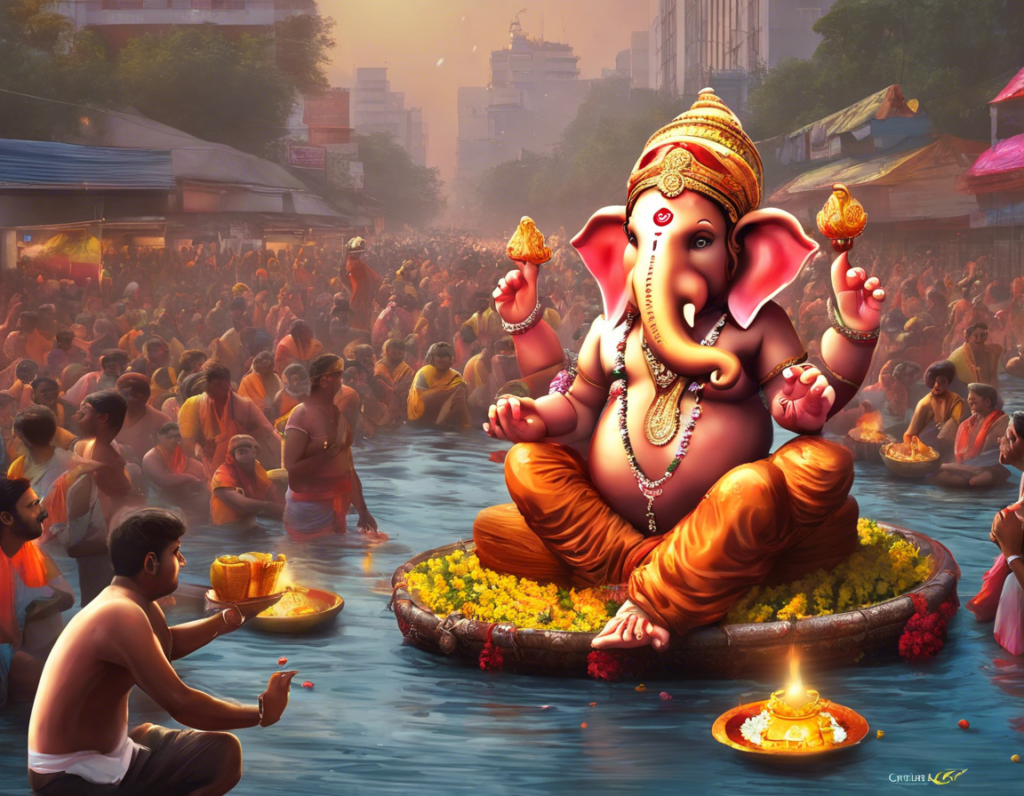
- May 23, 2024
- 6:29 pm
- No Comments
The festival of Ganesh Chaturthi holds immense significance in Hindu culture, particularly in the state of Maharashtra in India. The ten-day festival celebrates the birth of Lord Ganesha, the elephant-headed god of wisdom and prosperity. On the last day of the festival, devotees bid farewell to their beloved deity through a ritualistic immersion of the idol in water, known as Ganpati Visarjan.
The Significance of Ganpati Visarjan
Ganpati Visarjan marks the conclusion of the fervent celebrations that began with the installation of elaborately crafted idols of Lord Ganesha in homes and pandals. It symbolizes the departure of Lord Ganesha to his celestial abode, with devotees beseeching him to return soon the following year. The immersion process is accompanied by chants, music, and dancing, creating a vibrant and emotional atmosphere.
Rituals and Traditions
Ganpati Visarjan is a grand affair with processions carrying the idol through the streets towards a water body, such as a river, lake, or the sea. The atmosphere is charged with devotion and energy as the devotees bid farewell to their beloved deity. The immersion is a symbol of the cycle of creation and dissolution in Hindu philosophy, reminding the devotees of the impermanence of life and the transient nature of material wealth.
1. Sthapana (Installation):
- The festival begins with the sthapana (installation) of the Ganesha idol in homes or public pandals.
- The idol is decorated with flowers, garlands, and ornaments, and offerings of modak, his favorite sweet, are made.
2. Puja and Aarti:
- Devotees perform daily pujas (ritual prayers) and aartis (light offerings) to seek the blessings of Lord Ganesha.
3. Visarjan Procession:
- On the final day, large processions, accompanied by drumbeats and chants, carry the idols towards the water bodies.
- Devotees sing farewell songs and dance during the procession.
4. Immersing the Idol:
- The idol is gently immersed in the water, symbolizing the return of Lord Ganesha to his heavenly abode.
- Devotees bid an emotional farewell, expressing their gratitude and seeking his blessings for the coming year.
Eco-Friendly Initiatives
In recent years, there has been a growing awareness about the environmental impact of the traditional Ganpati Visarjan practices, where idols made of plaster of paris and toxic chemicals posed a threat to water bodies. To address this concern, many eco-conscious initiatives have emerged encouraging the use of eco-friendly idols made from natural materials like clay and biodegradable substances.
Tips for a Sustainable Visarjan
1. Opt for Eco-Friendly Idols:
- Choose idols made of clay or natural materials that dissolve easily in water without harming the ecosystem.
2. Avoid Harmful Chemicals:
- Refrain from using idols painted with toxic chemicals that pollute the water bodies.
3. Artificial Immersion Ponds:
- Some communities set up artificial immersion ponds to collect the idols for eco-friendly disposal.
4. Biodegradable Offerings:
- Use natural offerings like flowers and leaves instead of non-biodegradable items for the puja.
The Emotional Connect
Ganpati Visarjan is not just a religious ritual; it is a manifestation of the emotional bond between the devotees and their beloved deity. The festival brings communities together, fostering a sense of unity and devotion. The chants of “Ganpati Bappa Morya, Pudhchya Varshi Lavkar Ya” (O Lord Ganesha, come back soon next year) resonate in the air, echoing the fervent hope for the swift return of the elephant-headed god.
FAQ on Ganpati Visarjan
Q1: What is the significance of Ganpati Visarjan?
A: Ganpati Visarjan marks the farewell of Lord Ganesha at the end of the Ganesh Chaturthi festival, symbolizing his return to his heavenly abode.
Q2: When is Ganpati Visarjan celebrated?
A: Ganpati Visarjan is usually observed on the 11th day after the start of Ganesh Chaturthi, which falls in the Hindu month of Bhadrapada.
Q3: How is the immersion procession during Ganpati Visarjan?
A: The immersion procession involves chanting, singing devotional songs, and dancing as devotees carry the idol of Lord Ganesha to a water body for immersion.
Q4: Are there eco-friendly practices for Ganpati Visarjan?
A: Yes, eco-friendly initiatives include using natural clay idols, avoiding toxic chemicals, and opting for biodegradable offerings to minimize environmental impact.
Q5: What are the traditional rituals associated with Ganpati Visarjan?
A: The rituals include daily pujas, aartis, offerings of modak, and the final immersion of the idol amidst devotional fervor.
From the grand processions to the emotional farewells, Ganpati Visarjan embodies the essence of devotion, community spirit, and environmental consciousness. It is a celebration that transcends religious boundaries, uniting people in their reverence for the benevolent Lord Ganesha.